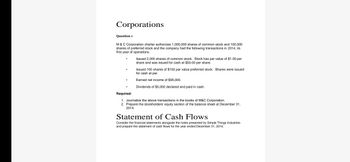Consider the financial statements alongside the notes presented by Simple Things Industries and prepare the statement of cash flows for the year ended December 31, 2014. Assets Current: Cash Accounts Receivable Inventory Plant assets, net Total Assets Liabilities Current: Accounts payable Accrued liabilities Long-term notes payable Stockholders' Equity Common Stock Retained earnings Treasury stock Total liabilities and stockholders' equity Revenues and gains: Sales revenue Interest re ve nue Dividend revenue Gain on sale of plant assets Total revenues and gains Simple Things Industries Ltd. Comparative Balance Sheet December 31, 2014 and 2013 Expenses Cost of goods sold Salary and wages expense Depreciation expense Other operating expense Interest expense Income tax expense Total expenses Net Income /(Loss) Simple Things Industries Ltd Income Statement Year Ended December 31,2014 Notes Acquisition of plant asset during 2014 Sale proceeds from sale of plant asset Receipt for issuance of notes payable Payment for note payable Dividend paid 2014 22,000 90,000 143,000 460,000 715,000 90,000 5,000 160,000 370,000 110,000 (20,000) 715,000 286,000 12,000 9,000 10,000 156,000 56,000 20,000 16,000 15,000 14,000 2013 Increase/(Decrease) 42,000 73,000 145,000 210,000 470,000 50,000 10,000 80,000 250,000 80,000 470,000 317,000 277,000 40,000 (20,000) 17,000 (2,000) 250,000 245,000 40,000 (5,000) 80,000 120,000 30,000 (20,000) 245,000 310,000 50,000 90,000 10,000 10,000
Reporting Cash Flows
Reporting of cash flows means a statement of cash flow which is a financial statement. A cash flow statement is prepared by gathering all the data regarding inflows and outflows of a company. The cash flow statement includes cash inflows and outflows from various activities such as operating, financing, and investment. Reporting this statement is important because it is the main financial statement of the company.
Balance Sheet
A balance sheet is an integral part of the set of financial statements of an organization that reports the assets, liabilities, equity (shareholding) capital, other short and long-term debts, along with other related items. A balance sheet is one of the most critical measures of the financial performance and position of the company, and as the name suggests, the statement must balance the assets against the liabilities and equity. The assets are what the company owns, and the liabilities represent what the company owes. Equity represents the amount invested in the business, either by the promoters of the company or by external shareholders. The total assets must match total liabilities plus equity.
Financial Statements
Financial statements are written records of an organization which provide a true and real picture of business activities. It shows the financial position and the operating performance of the company. It is prepared at the end of every financial cycle. It includes three main components that are balance sheet, income statement and cash flow statement.
Owner's Capital
Before we begin to understand what Owner’s capital is and what Equity financing is to an organization, it is important to understand some basic accounting terminologies. A double-entry bookkeeping system Normal account balances are those which are expected to have either a debit balance or a credit balance, depending on the nature of the account. An asset account will have a debit balance as normal balance because an asset is a debit account. Similarly, a liability account will have the normal balance as a credit balance because it is amount owed, representing a credit account. Equity is also said to have a credit balance as its normal balance. However, sometimes the normal balances may be reversed, often due to incorrect journal or posting entries or other accounting/ clerical errors.

Step by step
Solved in 2 steps with 1 images

In addition to the attached also show operating activities









